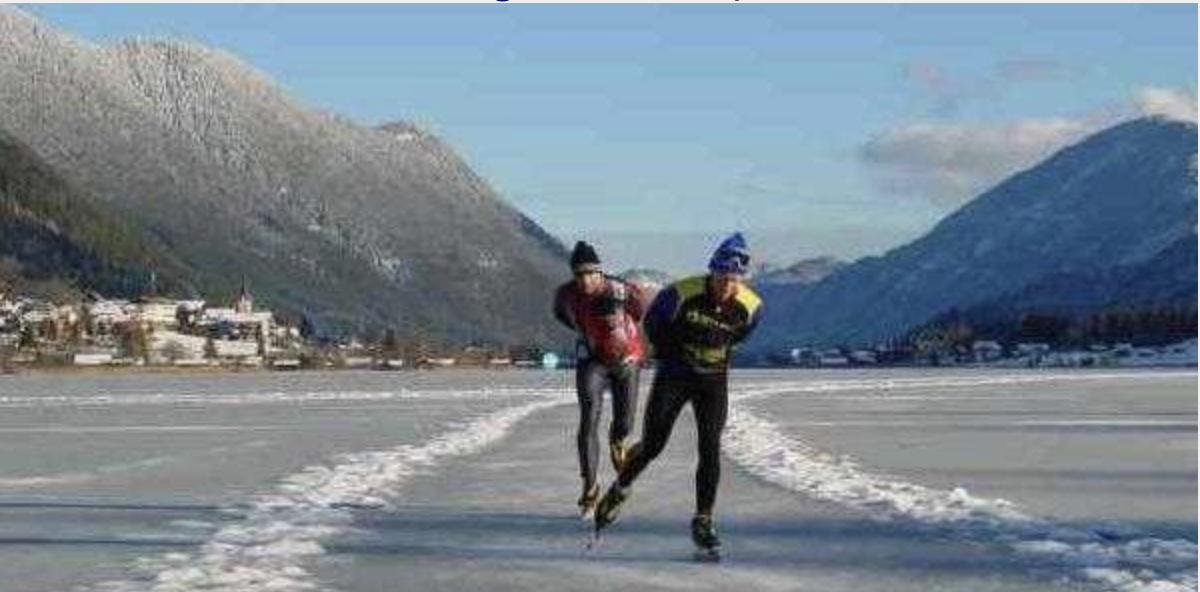The Weissensee in Austria
Every winter in late January, thousands of skaters converge on the Austrian Alps for ten days of skating tours and races, long and short, including four 200-kilometer events for skaters of varying abilities, from novices to world champions.
Can you really skate 125 miles in a day? Weissensee is the place to find out.
Like Norway's fjords, the lake is long and narrow, nine miles from end to end. Its midsection is lined with sheer mountain walls, the shoreline inaccessible by road. The lake water is clean enough to drink, and so clear you can see the bottom 30 feet down.
The remote east end has only a handful of chalets, but a picturesque farming village perches above the west end. From the village's quaint bed-and-breakfast pensions you can see the entire lake, plus the snowcapped Alps. There's both alpine and cross-country skiing within walking distance. Walk to the lake too, where you'll find a machine-groomed skating trail that can be up to 25 kilometers long.
Most days are sunny and mild with no wind. Lakeside cafes drag tables and chairs onto the ice, so you can relax and enjoy lunch in the warm sunshine without taking your skates off. In the evening a festive atmosphere reigns, as everyone walks or bikes to the village hotels for a delicious and inexpensive dinner.
What's it like to skate 200K?
Get up before dawn, eat a big breakfast and fill your water bottle. Then, just before sunrise, join hundreds of skaters gliding silently out to the start on Nordic skates and cross-country ski boots.
The starting gun goes off. If you can skate in a peloton in close proximity to fellow skaters, you can breeze through the first 100 kilometers in as little as three hours, drafting behind the leaders. If you lose the peloton, stop at a food station to eat, drink and wait for another group. Relax and enjoy the scenery. Even if your second 100K takes four hours, you'll still finish in seven. Pick up your medal and certificate, and skate back to your pension for a well-deserved rest.
The morning after
You'll be stiff, but you'll still be able to skate. Slowly. By evening you'll be ready for a long, leisurely dinner. In the hotel lobby, you may see loaves of fresh-baked raisin bread and crates of freshly-peeled oranges stacked high on the tables, ready for the next day's tour. Inspired by the sight, you may have an irresistible urge to get up early the next morning and skate another 50, 100 or 200 kilometers. You won't go hungry. Then celebrate by dancing the night away at the Blister Ball.
Suppose I don't want to skate that far?
Skate as little as 50K and you'll still earn a Weissensee medal and certificate. But be sure to take advantage of all that Weissensee offers. Walk to downhill and cross-country skiing, mountain bike trails, shopping and restaurants. Explore the village's narrow streets past old churches, farmhouses and barns. And even if you don't skate in the official tours, take a leisurely trip to the east end of the lake, at mid-day when the sun climbs above the southern cliffs and warms the north shore. Watch the world's fastest skaters hurtle down the trail at speeds of 25 to 30 miles per hour. Then try it yourself. Warning: Skating and skiing at the Weissensee can be habit-forming. Auf wiedersehen - see you in January.
More information: http://weissensee.at/ and https://www.weissensee.nl/


